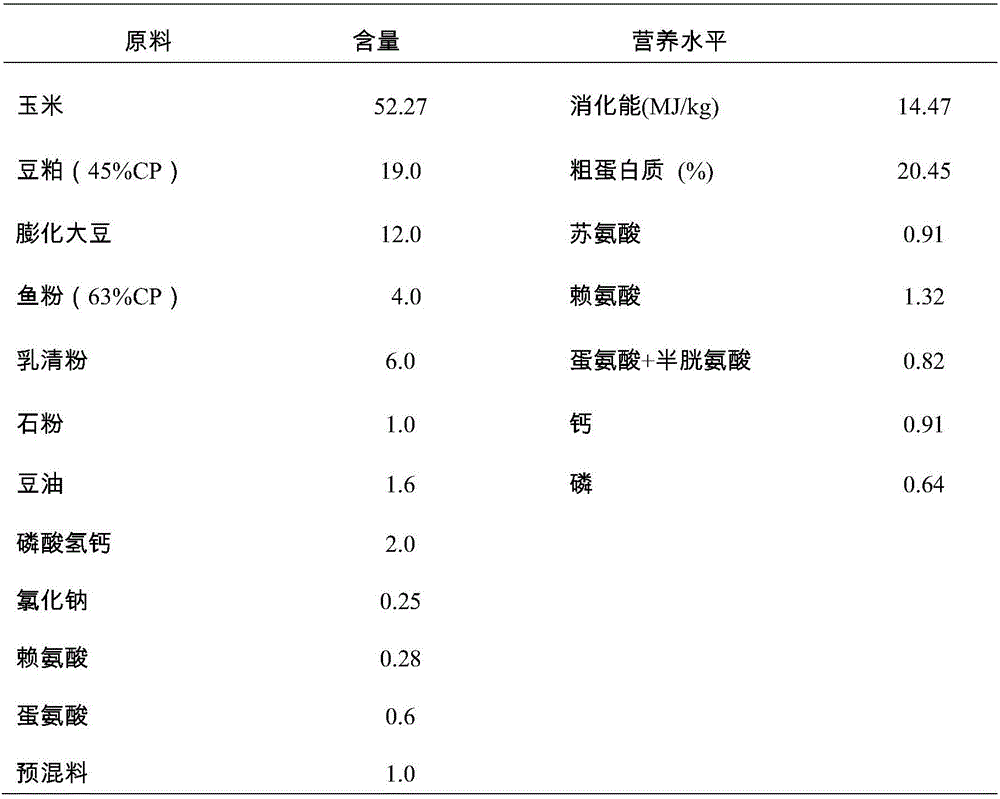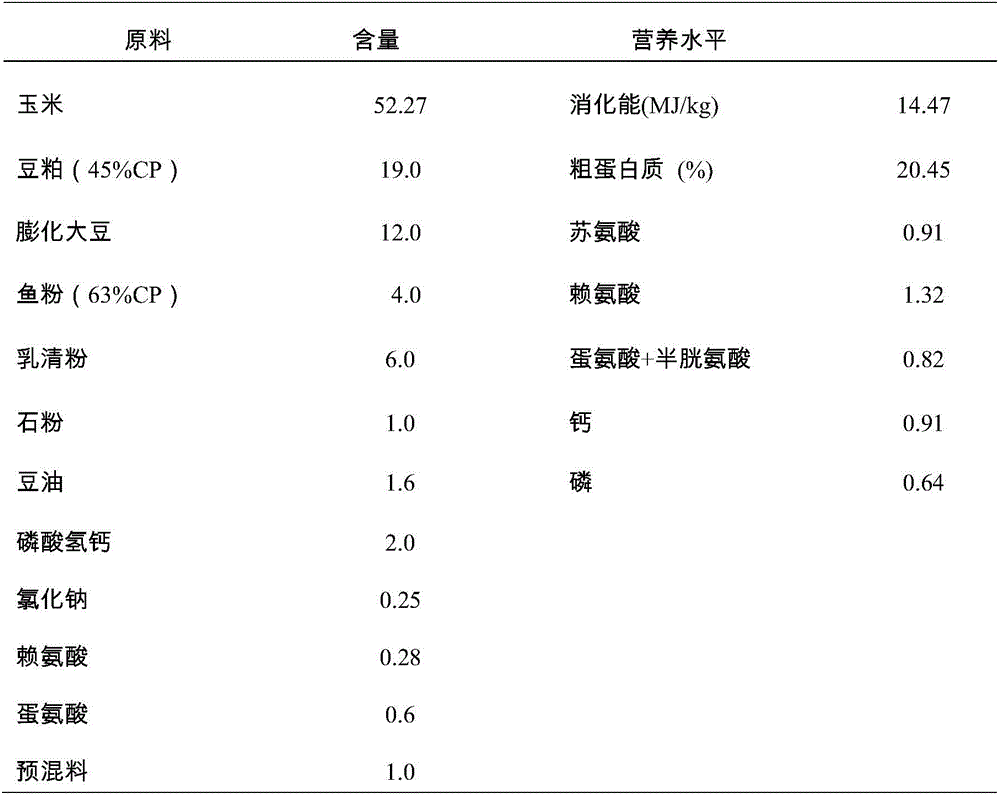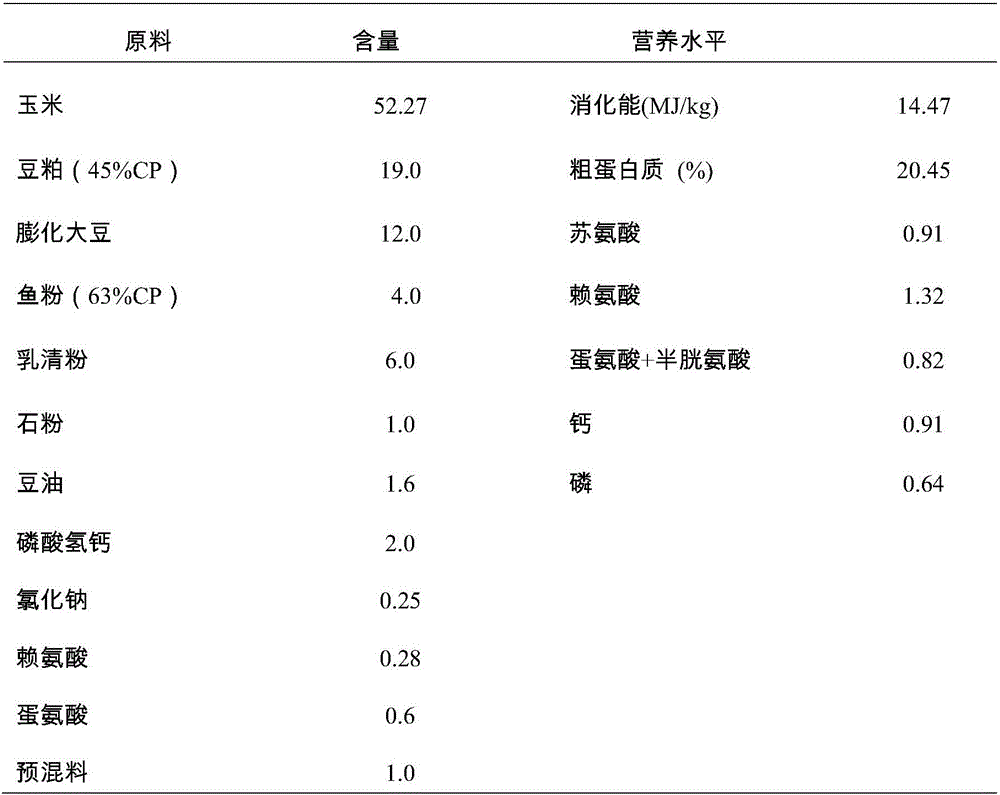Piglet intestine nutrition regulation and control feed containing cladded zinc oxide
A nutritional regulation, zinc oxide technology, applied in animal feed, application, animal husbandry, etc., can solve the problems of affecting growth and development, environmental pollution, thick and long hair, and achieve the effect of improving growth performance and reducing diarrhea rate.
- Summary
- Abstract
- Description
- Claims
- Application Information
AI Technical Summary
Problems solved by technology
Method used
Image
Examples
Embodiment 1
[0016] At the beginning of weaning of 25-day-old piglets, the control group was fed the control diet (see Table 1 for formula). On the basis of the diet of the control group, 0.06% of coated zinc oxide or 0.1% of sodium butyrate was added to the complete feed of the test group, and the above feed was fed until 46 days old, and the growth performance of piglets was measured.
[0017] Table 1 Test diet composition and nutritional indicators
[0018]
[0019] The test results showed that compared with the control group, the average daily gain of piglets in the coated zinc oxide test group increased by 10% (P<0.05), the feed-to-weight ratio decreased by 6% (P<0.05), and the diarrhea rate decreased by 45% (P<0.05). 0.05), the height of jejunal villi increased by 20% (P<0.05), the depth of crypts decreased by 10% (P<0.05), the activity of duodenal enterokinase increased by 18% (P<0.05), and the activity of jejunal mucosal lactase increased 15% (P<0.05), the invertase activity in...
Embodiment 2
[0021] At the beginning of weaning of 25-day-old piglets, the control group was fed the control diet (see Table 1 for formula). On the basis of the diet of the control group, 0.06% of coated zinc oxide and 0.1% of sodium butyrate were added to the full-price feed of the test group. The piglets were fed with the above feed until 46 days old, and the growth performance of piglets was measured.
[0022] Table 1 Test diet composition and nutritional indicators
[0023]
[0024] The test results showed that compared with the control group, the average daily gain of piglets in the test group increased by 20% (P<0.05), the feed-to-weight ratio decreased by 10% (P<0.05), and the diarrhea rate decreased by 75% (P<0.01). The height increased by 60% (P<0.05), the crypt depth decreased by 20% (P<0.05), the activity of duodenal enterokinase increased by 30% (P<0.05), and the activity of jejunum lactase increased by 25% (P<0.05). 0.05), the invertase activity increased by 30% (P<0.05). ...
Embodiment 3
[0026] At the beginning of weaning of 21-day-old piglets, the control group was fed the control diet (see Table 1 for formula). On the basis of the diet of the control group, 0.2% of coated zinc oxide and 0.2% of sodium butyrate were added to the complete feed of the test group, and the above feed was fed to 42 days old, and the growth performance of piglets was measured.
[0027] Table 1 Experimental diet composition and nutritional indicators
[0028]
[0029] The test results showed that compared with the control group, the average daily gain of the piglets in the test group increased by 31% (P<0.01), the feed-to-weight ratio decreased by 12% (P<0.05), and the diarrhea rate decreased by 80% (P<0.01). The height increased by 90% (P<0.01), the crypt depth decreased by 50% (P<0.05), the activity of duodenal enterokinase increased by 35% (P<0.05), and the activity of jejunum lactase increased by 35% (P<0.05). 0.05), the invertase activity increased by 60% (P<0.01).
PUM
 Login to View More
Login to View More Abstract
Description
Claims
Application Information
 Login to View More
Login to View More - R&D
- Intellectual Property
- Life Sciences
- Materials
- Tech Scout
- Unparalleled Data Quality
- Higher Quality Content
- 60% Fewer Hallucinations
Browse by: Latest US Patents, China's latest patents, Technical Efficacy Thesaurus, Application Domain, Technology Topic, Popular Technical Reports.
© 2025 PatSnap. All rights reserved.Legal|Privacy policy|Modern Slavery Act Transparency Statement|Sitemap|About US| Contact US: help@patsnap.com



